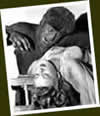Movies

New Releases • A-D • E-H • I-P • Q-Z • Articles • Festivals • Interviews • Dark Knight • Indiana Jones • MCU
The Wolfman (2010/Blu-ray)
Directed by Joe Johnston
Rated R/Unrated
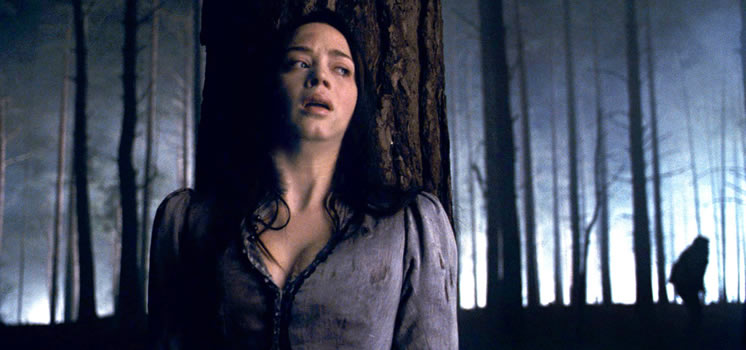
Gwen Conliffe (Emily Blunt) seeks refuge from The Wolfman
Photo: Universal Pictures
An outstanding collection of Blu-ray-exclusive features has transformed an anemic theatrical production into a home video release with considerable bite.
Lycanthropy
It seemed like a no-brainer to update the wolfman legend, especially with all of the modern moviemaking techniques at Hollywood's disposal. Then again, while Francis Ford Coppola's take on Dracula was tremendous, Kenneth Branagh's subsequent Frankenstein was anything but.
In the case of The Wolfman, the end result lies somewhere in between.
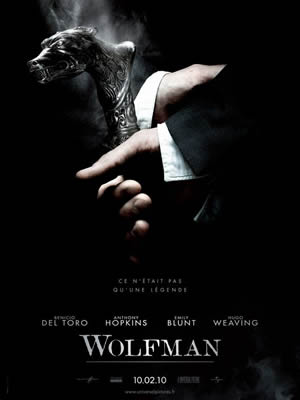
But first, let's back up and revisit the rules from the 1941 classic The Wolf Man. There are three ways to kill a werewolf: shoot it with a silver bullet, stab it with a silver blade, or whack it but good with the silver handle of a walking stick. And there's no cure.
The biggest surprise, and what possibly undermined this remake's commercial success, was an ambitious storyline which didn't simply retell the slight 1941 story, but rather overhauled it and pushed it back in time to 1891, when Victorian England offered plenty of opportunities for lush scenery, extravagant costumes, and oodles of foggy moodiness. In many ways, this remake is in name only—the lead characters' names are the same. And some refashioned props also make cameo appearances: there's a wolf's head cane, a telescope, and the creepy pentagram on the palm.
This time around, the story is more hard core with generous doses of hard gore. In addition to the aforementioned methods of slaying a werewolf, this version reintroduces another concept from legends of yore: beheading.
A new wrinkle is a murky subplot about love providing a release from the bonds of wolfiness. Exactly how love factors into things as a release mechanism is never directly addressed, but it doesn't really matter. Unfortunately for this Lawrence Talbot (Benicio Del Toro, Sin City), the apple of his eye in the 1941 movie, Gwen Conliffe (Emily Blunt, The Devil Wears Prada), is now engaged to his brother, Ben, who went missing. Gwen's enlisted Lawrence's help to find Ben. She doesn't love Lawrence. And even when a gypsy tells Gwen the only way to save Lawrence is if she loves him, she shirks back. Sure, she cares about the poor guy, that's why she dusted off some stygian books on the topic of lycanthropy in an 1800s version of self-help. But she doesn't love him, especially after a pretty passionless kiss. That's about as unromantic as it gets. Considering The Wolfman was released on Valentine's Day weekend, that's some interesting counter-programming.
As for Lawrence's dad, Sir John Talbot (Anthony Hopkins, Dracula), he doesn't love his son either. He sent him away when he was a kid and Lawrence wound up growing up in the United States, where he became a master thespian. How ironic that Gwen would find him in London as the lead in a touring production of Hamlet.
Howl at the Moon
For screenwriters Andrew Kevin Walker (Seven, Sleepy Hollow) and David Self (Road to Perdition), it seems the goal wasn't so much to remake the Lon Chaney Jr. flick, but rather to tell a more definitive werewolf tale, branching out from Curt Siodmak's 1941 screenplay to include concepts from centuries-old legends. In many respects, they succeeded.
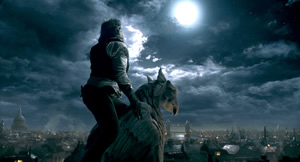
A full moon over London
Image: Universal Pictures
But this was a troubled production, there's no denying it. Production delays, reshoots, and—no doubt—many creative differences forced the movie's release date to be pushed out at least three times. The end result in some respects is a creative mess, but it's a creative one nonetheless.
The strengths of the new screenplay include incorporating the barbaric techniques used to treat the mentally ill back in the late 1800s and a far more interesting father-son relationship that is much more sinister and tortured than the oddly detached Claude Rains-Lon Chaney Jr. version. At first, it seems like Hopkins is merely playing another loon, but there is a very fine, devilish sense of humor in his work here.
Of course, a key element here is the werewolf transformation itself. The effects are absolutely spectacular and top notch. In particular, Lawrence's transformation in a lecture hall full of doctors is classic moviemaking in its own right. This certainly isn't 1940s puritanism, either. Back then, Chaney couldn't even show his wolf-bite scar onscreen. He'd flash his chest offscreen, leaving the horror strictly to the imagination. Later on, Chaney's shown in a scar-concealing wife beater. Such innocence is gone here. The blood flows early and often in what is by far, to date, the most violent movie from director Joe Johnston (Jurassic Park III, Hidalgo).
A Tale of Two Wolves
What makes this Blu-ray release particularly fascinating is the inclusion of both the theatrical release and an extended, unrated director's cut. Home video releases of unrated cuts are a common marketing ploy these days, but oftentimes they're precious little more than that: a marketing ploy. Director's cuts of movies like The Boondock Saints and Drag Me to Hell offer mere seconds of differences that aren't even worth pinning down. They're legal obligations at best.
In this case, though, the two cuts offer a rare treat that presents a sort of exploration of the creative process. There are some significant differences in the storytelling and a whopping 16 minutes of additional footage in the director's cut. The differences come fast and furious, starting with the studio's logo. Theatrically, it was a bleached, quasi-monochromatic version of the current logo animation. The director's cut offers a refreshed, widescreen spin on the classic black-and-white logo, a very nice touch that immediately sets the mood by harking back to the theatrical experience of the original 1941 release.
From there, the theatrical cut speeds things up with Gwen writing a letter to Lawrence seeking his help. It's made clear by an advertisement on her desk that Lawrence is an esteemed thespian. What works more interestingly in terms of setting up the characters and their relationships is the director's cut, in which Gwen visits Lawrence backstage after a performance. And that's followed by a train sequence in which Lawrence encounters a real-life master thespian, Max Von Sydow (Flash Gordon), whose mysterious character introduces Lawrence to a spiffy walking stick with a wolf's head handle that also serves as the hilt for a blade concealed in the stick's shaft.
Isn't there a rule that if you manage to cast Max Von Sydow it's absolutely verboten to leave his work on the cutting room floor? If there isn't, there should be. In the case of the theatrical cut, it not only denies audiences a chance to watch the great, great actor at work, it also omits the set up for the use of the cane's blade later in the movie.
Those are merely a couple major examples of where the two cuts differ. Unfortunately, the letter versus in-person difference leads to a domino effect of discrepancies later in the director's cut. During a couple conversations, Gwen's letter is referred to rather than her in-person meeting with Lawrence. Even so, it offers a peek at the very human and organic way in which big-budget movies are still made, even in this high-tech day and age.
Blu-ray Extras
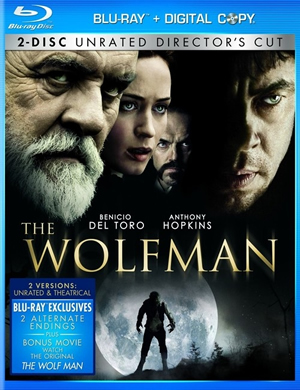
There two deleted and three extended scenes, totaling 11 minutes, most of which feels like kitchen sink footage. One scene shows Lawrence lying on a polar bear skin floor rug while talking to Gwen. His posture comes across as alluring, as if Gwen should be lying there rather than Lawrence. While the conversation is decent, it's understandable while it was cut. During an extended London chase sequence, Wolfman enters a masked ball, receiving compliments on the excellence of his costume while he makes his way through the crowd to a blind singer. Following that odd confrontation, Wolfman attacks a puppeteer performing a skit about a man hunting a wolf. There are also extended versions of the transformation in the mausoleum and the final fight in Talbot Manor. Perhaps the most interesting scene is Singh, Sir Talbot's servant, telling Larry about how Sir Talbot saved his life.
Also available to both DVD and Blu-ray owners is the opportunity to stream the original 1941 movie online. Actually, anybody with a UniversalHiDef.com account can do this without either disc. The streaming ends Dec. 1, 2010.
Blu-ray Exclusives
In terms of supplemental features, this is one of the best Blu-ray releases in quite some time. This is what the format is all about. Not just behind-the-scenes featurettes, but a full-bodied, high-tech package that digs deep into the roots of the source material and beyond. The end result is a greater appreciation for the film itself.
It's incredible Disney's Alice in Wonderland earned more than a billion dollars at the global box office, but the Blu-ray coughed up only 48 minutes of featurettes and a digital copy. Avatar, sitting on 3 billion dollars, packed no extra features, aside from a free-standing promotional Web site/desktop doohickey. The Wolfman was a relative flop, yet its Blu-ray release is jam-packed with an incredible amount of quality supplemental material.
While the jacket's front and back herald the inclusion of two never-before-seen alternate endings, the really juicy stuff is found in the U-Control track called Legacy, Legend and Lore, available as a companion to the theatrical cut. This is one of the best picture-in-picture tracks yet as it provides an excellent blend of video, audio, text, and graphics. A variety of topics are served up, including trivia from Universal horror movies and the deep, deep background of werewolves from long ago. The track uses clips from the original 1941 movie along with other movies, including An American Werewolf in London. The historical content includes real-life werewolf cases and legends. One nifty tidbit regarding the 2010 remake: The Scotland Yard investigator played by Hugo Weaving was named after a real-life investigator on the Jack the Ripper case and was, basically, the same character Johnny Depp portrayed in From Hell. There's also a surprising revelation about the origin of the "silver bullet" solution. The track is punctuated with nice moments of humor, including an observation about the classic "foreigner moment."
Also well-done, but not as extensive, is the Take Control track, which features make-up effects genius Rick Baker, cinematographer Shelly Johnson, and visual effects producer Karen Murphy. It's not as slick as Warner's Maximum Movie Mode, but it's cool. And, while the content is sporadic, it works well and avoids simply being a rehash of the content from the featurettes. It also includes what is quite possibly the supplemental quote of the year, courtesy of Murphy regarding the scene in which the Wolfman throws Lawrence's doctor out the window: "Mwuh... nice impale."
As for the two alternate endings, both are pretty interesting. One could be called The Bride of the Wolfman ending while the other is a more tragic twist that leaves the door open for Del Toro to return in The Wolfman 2. Similar to the comparison of the theatrical and director's cuts, these alternate endings are an interesting look at the creative process, as both set a different tone.
The set also includes four featurettes.
Return of The Wolfman is a 12-minute assembly of too-serious chatter, but woven in is some additional deleted footage.
Transformation Secrets is a solid, 15-minute technical look at the transformation effects.
The Beast Maker is a 12-minute look at Rick Baker, the de facto effects guy who pursued the opportunity because, darn it, he was the right guy for the job.
The Wolfman Unleashed is a great 8-minute behind-the-scenes look at the stunt work. What makes this particularly interesting is the extensive amount of practical effects used in the production. It's unfortunate the very real, on-set effects get buried under the dominating CGI effects work.
The feature presentation is D-Box enabled, for those with the required equipment. The disc also supports "pocket BLU," enabling smart phones to act like a remote and other extraneous stuff that really isn't Blu-ray relevant.
The second disc in this set holds the digital copy download of the director's cut, for use on PCs, Macs, and portable devices.
Even with all the above, there's one thing that would've been nice to have, something that would've made this home-based film school class complete: a commentary from director Joe Johnston explaining the rationale behind the different cuts, or at least a video introduction to the director's cut covering the topic. This probably isn't an egregious example of ego-based creative differences as was the case that led to the cinematically-historic battle between Terry Gilliam and Universal over his movie Brazil (the Criterion edition of Brazil, with three different edits of the movie, is an absolute must for film students), but it'd be interesting to hear Johnston's take, nonetheless.
Picture and Sound
Given all the effort put into the Blu-ray features, the picture quality of the feature presentation (1.85:1) has to be called into question. There are a lot of candlelit scenes that feature an odd halo effect that doesn't seem right. In the Take Control track, Shelly Johnson indirectly confirms the problem is with the Blu-ray when he boasts of the spectacular lighting that was achieved using only candlelight and a new film stock. Other scenes, particularly those filmed outdoors, are perfectly fine. Perhaps somebody wasn't tuned in to the film's atmospheric nuances while conducting the transfer. Adjustments to the contrast and black and white levels mitigated the problem, but at the expense of creating minor image issues elsewhere. It's most certainly a finicky film to present.
Aurally, the Blu-ray is well done. The English 5.1 DTS HD Master Audio track is full bodied, providing an atmospheric surround sound that makes the wolfman's howl spectacularly chilling. Alternative tracks are Spanish 5.1 DTS Surround, French 5.1 DTS Surround, and Descriptive Video Service (DVS).
Optional subtitles are available in English SDH, Spanish, and French.
How to Use This Disc
Watch the director's cut. If curious, check out the alternate endings for a little something to think about. Movie and trivia fans should also switch over to the theatrical cut and turn on the Legacy, Legend and Lore track.
• Originally published at MovieHabit.com.
